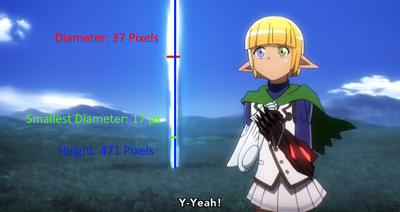Introduction[]
In Overlord, Ainz Ooal Gown possesses very potent Super Tier magic spell. The spell unleashes a pillar of blinding, incinerating magic. He has used it twice in the series, both against Shalltear Bloodfallen, with the second being successful in killing her.
How does it kill her? Vaporization. But this isn't just a single target ability; Fallen Down is a huge area of effect spell that casts a massive pillar of magic to incinerate all within it. We see part of its power, since it leaves a large, seared crater behind, but most of this attack isn't on the ground, it is in the sky.
So how hot is the pillar and how much air would it have raised to this temperature?
Assumptions[]
1. The spell is identical in functionality the first and second time it is used.
2. The spell is capable of vaporizing iron, as even Shalltear's armor vanishes.
3. The spell not only vaporizes the land that forms the crater, but also raises the air temperature to the same temperature that is needed to vaporize steel.
The Calc[]
So let's get into it. Credit to Mr. Bambu for the first picture. I need to find height and radius. The height originally was obtained incorrectly. The angled top-down shot of the crater will add some of the length of the crater to its apperent height, which we don't need. To get real height, we need to draw a line from a far edge to the center of the crater. This will be a more accurate way to obtain the height. That line will also serve as radius.

-
-
-
-
-
-
I judged where the middle of the hole is by looking at the angle of the rocks. Using that we can find a lowball radius and the height of the crater. Unfortunate there is no way of knowing how fast the crater cuts off thanks to the angle of the shot, so we will have to lowball it by having a line from the edge of the frame to the epicenter.
The radius is 1897 pixels. The height is 109 pixels. Since Shalltear is 140cm tall and appears as 18 pixels, each pixel is 7.778cm. This indicates that the height is 847.802 cm, or 8.478 meters, and the radius is 14754.866 cm, or 147.549 meters. Thus 773,000 cubic meters of stone was raised to the temperature of vaporized iron.
Assuming the stone was at a nice 23 degrees Celsius (around room temp), it would need to undergo a 2839 degree temperature change to get to 2862 degrees, the vaporization point of iron.
The specific heat capacity of granite (assuming this is the stone vaporized, since it is a generic stone) is 821.46 j/kgK. The density of granite is 2650 kg/m^3. Therefore the mass is 773,000*2650 = 2,048,450,000 kg, or 2.048x10^9 kg.
Therefore energy = (2.048x10^9)*(821.46)*(2839) = 4.776x10^15 joules, Small City level.
I honestly don't know where some of the values Bambu used came from. Sorry, this part isn't much of an upgrade. But let's move on to the upward shot.

-
-
-
-
-
-
The largest area of the blast will be used as the diameter in order to not inflate the results. It is 37px in diameter. The height is 471px. Since we know half of 37px = 147.549 meters, we know each pixel is 3.988*2 = 7.976 meters. The smallest portion of the diameter is 17px. If we average the largest and smallest portions, we know the average diameter is 27px.
Therefore the average diameter is 215.352 meters, or 107.676 meters in radius. The height is 3756.696 meters. The volume of this cylinder is 1.37×10^8 cubic meters. The density of air 1.225 kg/^3, and thus mass is 167,825,000 kg. The nominal value of the specific heat capacity of air is 718 j/kgK.
Therefore energy = (1.678x10^8)*(718)*(2839) =3.42x10^14 joules, Town level+. Now we can combine both these values to get the final result.
(3.42x10^14)+(4.776x10^15) = 5.118x10^15 joules, Small City level.
Well, sorry to disappoint but it looks like the result isn't impressive since the original calc seems to have errors.
Edit: I also need to account for the latent heat fusion and vaporization of the granite, since it phases shifted from solid to gas. Not only was it melted (latent heat fusion) but also vaporized (latent heat vaporization).
Same mass using both the fusion and vaporization values of granite.
((2.048x10^9)*947,657.98)+((2.048x10^9)*6,077,872) = 1.439x10^16 joules
So we add that value on to our total to get 1.951x10^16 joules, Small City level+

